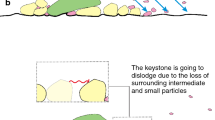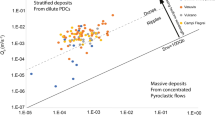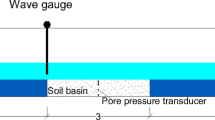Abstract
The interrelationships between fluid flows and the surface forms of underlying movable beds are crucial in interpreting sedimentary structures and in predicting hydraulic drag. Energetic flows can erode all features from a sediment bed, and transition to such a planar bed is important to the processes of sediment transport by waves1. The following analysis connects bed planation to a threshold effect in hindered settling with increasing concentration of noncohesive sediment moving near the bed. Calculated fluid velocity from the resulting quantitative criterion for this bed transition agrees with extensive laboratory data2,3 in oscillatory flows.
This is a preview of subscription content, access via your institution
Access options
Subscribe to this journal
Receive 51 print issues and online access
$199.00 per year
only $3.90 per issue
Buy this article
- Purchase on Springer Link
- Instant access to full article PDF
Prices may be subject to local taxes which are calculated during checkout
Similar content being viewed by others
References
Komar, P. D. & Miller, M. C. J. Sedim. Petrol. 45, 697–703 (1975).
Manohar, M. Beach Eros. Bd Tech. Mem. No. 75 (1955).
Chan, K. W. et al. Proc. R. Soc. A330, 537–559 (1972).
Sleath, J. F. A. J. WatWays Harb. coast. Engng Div. Am. Soc. civ. Engrs 100 (WW2) 105–122 (1974).
Jonsson, I. G. ISVA Ser. Pap. 17 (Technical University of Denmark, Lyngby, 1978).
Hallermeier, R. J. Continental Shelf Res. (submitted).
Bagnold, R. A. Proc. R. Soc. A332, 473–504 (1973).
Kamphuis, J. W. J. WatWays Harb. coast. Engng Div. Am. Soc. civ. Engrs 101 (WW2) 135–144 (1975).
Hallermeier, R. J. J. WatWay Port coast. Ocean Div. Am. Soc. civ. Engrs 106 (WW3) 299–318 (1980).
Schlichting, H. Boundary-Layer Theory, 6th edn (McGraw-Hill, New York, 1968).
Engelund, F. & Hansen, E. A Monograph on Sediment Transport in Alluvial Streams (Teknisk Forlag, Copenhagen, 1967).
Nayak, I. V. Tech. Rep. HEL 2–25 (University of California, Berkeley, 1970).
Yalin, M. S. Mechanics of Sediment Transport 2nd edn (Pergamon, Oxford, 1977).
Richardson, J. F. & Jeronimo, M. A. daS. Chem. engng Sci. 34, 1419–1422 (1979).
Hallermeier, R. J. Sedimentology 28, 859–865 (1981).
Bagnold, R. A. Phil. Trans. R. Soc. A249, 234–297 (1956).
Leeder, M. R. Earth Surf. Processes 4, 229–240 (1979).
Kennedy, J. F. & Falcon, M. Hydrodyn. Lab. Rep. 86 (Massachusetts Institute of Technology, Cambridge, 1965).
Bagnold, R. A. Proc. R. Soc. A187, 1–18 (1946).
Hino, M. et al. J. Fluid Mech. 75, 193–207 (1976).
Lofquist, K. E. B. Coast. Engng Res. Cen. Tech. Pap. 78–5 (Fort Belvoir, Virginia, 1978).
Bagnold, R. A. Geol. Surv. Prof. Pap. 422 -I (US Printing Office, Washington DC, (1966).
Allen, J. R. L. & Leeder, M. R. Sedimentology 27, 209–217 1980).
Author information
Authors and Affiliations
Rights and permissions
About this article
Cite this article
Hallermeier, R. Hindered bedload settling as a model of sand bed planation by water waves. Nature 297, 53–55 (1982). https://doi.org/10.1038/297053a0
Received:
Accepted:
Issue Date:
DOI: https://doi.org/10.1038/297053a0
This article is cited by
Comments
By submitting a comment you agree to abide by our Terms and Community Guidelines. If you find something abusive or that does not comply with our terms or guidelines please flag it as inappropriate.



